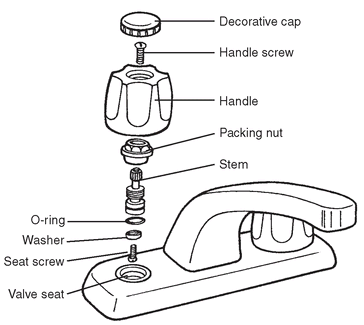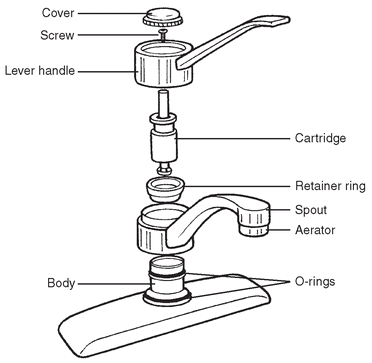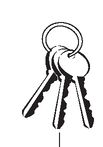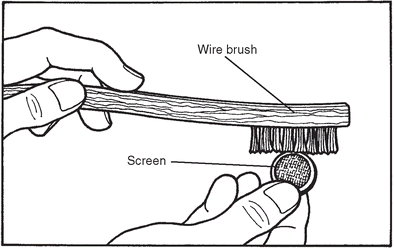Chapter 11
Controlling the Flow: Faucets, Sprays, and Showerheads
In This Chapter
• How faucets come apart and go together again
• Maintaining your sink sprayer
• Replacing a showerhead
• Adjusting a bathroom sink stopper so it opens and closes easily
Leaky hardware wastes a lot of water, and you don’t usually have to be a pro to make good fixes on your faucets, sprayers, and showerheads. And that drain stopper in the bathroom that won’t pop up—or go down? It’s easier to adjust than you think.
Faucet Facts
The drip, drip, drip of a leaky faucet is annoying, and getting to the cause of the problem may seem complicated. But the fix is usually the replacement of a small and inexpensive part. It just requires patience to get there and back!
If you have very old (50-plus years) faucets, the biggest problem with fixing them may be finding replacement washers and nuts. Follow the directions for fixing compression faucets, as old stem faucets are put together in much the same way. But most of the old stuff wore out long ago, so chances are you’ve got faucets that can be repaired with parts or kits that are easily obtainable to replace worn or broken components.
Modern faucets are a little more complicated than the old-fashioned kind. Some have lots of little pieces! Be methodical when you repair a multi-part gizmo like a faucet. Careful work is always more effective than a hurried job.
If you don’t know the brand and model number of your faucet, or it’s very old, you’ll need to remove it and bring it with you to find the correct size replacement parts and fittings.

Ounce of Prevention
If you’re going to take apart a faucet, clear an area where you can line up the pieces in the order you remove them. If you need to take parts to the store to find replacements, make a list of the parts and the order, so you can put things back the way you took them out. It’s always so frustrating to put something back together and have one piece left over!
Faucet Fix Prep List
Before you begin fixing any type of faucet, you’ll need to do four things:
1. Shut off the water at the supply stops under the sink; if you don’t have supply stops, shut off the water at the main. Drain whatever water remains in the faucet.
2. Close the sink drain with its stopper and cover it with a towel or rag—preferably white or light-colored. That way, if little faucet parts (some are tiny!) should fall in the sink, they won’t go down the drain. Lining the sink with a towel or cloth will also protect the finish if you drop your tools.
3. Tape the jaws of whatever pliers or wrenches you are using with masking or painter’s tape, so the tool doesn’t scratch the fixture.
4. Figure out where you’ll lay out your parts in order.
Basically, there are four types of faucets. The compression faucet has two handles. Opening or closing the handles, which in turn loosens or compresses the rubber washers at the base of the stem beneath each handle, controls the water flow (see the illustration in the next section). Because the key controller is made of rubber, which wears out more quickly than plastic, metal, or ceramic, this type of faucet needs repair more frequently than other types.
The other types of faucets are often called washerless faucets. Ball-type, cartridge, and ceramic disk faucets are appreciated for their sturdiness, but they also have small rubber and plastic seals and O-rings that are part of flow control and can wear out.
Balls, cartridges, and ceramic discs—the “works” of these other types of faucets—occasionally need replacement, but you can purchase the entire set of parts—the assembly—for much less than the cost of a new faucet. (You’re not buying the handle(s) and spout, just the innards.)
Every manufacturer makes many variations of each type of faucet, so it’s impossible to illustrate every detail of all of them. Use the illustrations shown as a general guide.

What Pros Know
If you get a printed diagram when you purchase parts or a faucet assembly, save it and put it in your home workbook (see Chapter 4). It’ll make the next repair easier.
Fixing a Leaky Compression Faucet
Generally, leaks from the spout indicate a worn washer; leaks from the handle are caused by a worn O-ring. Once you get the faucet apart, examining all the parts for wear and corrosion is a good idea. You can fix what’s broken and replace a worn part at the same time. Be sure to bring the defective part(s) with you to the store. O-rings and washers come in so many sizes, you need to know what will exactly replace the worn, damaged, or broken part.
Compression faucet.

You’ll need the following:
□ Adjustable wrench
□ Screwdrivers (Phillips and standard)
□ Penetrating oil or other lubricant
□ Fine steel wool

What Pros Know
When you buy replacement washers and O-rings for a compression faucet, always buy several—they’re cheap—label the leftovers, and keep them in your supply closet. That way you won’t have to disassemble the faucet and bring the works to the hardware store to find replacement washers, rings, and the like, next time.
□ Rag or towel
□ Heatproof plumber’s grease
□ Replacement parts: washers, O-rings, or packing
1. Do all the steps in the “Faucet Fix Prep List” earlier in this chapter.
2. If the handle screw is visible, unscrew it and lift the handle straight up and off. If you don’t see the handle screw, use the tip of the screwdriver to carefully lift off the decorative cap, which should reveal the handle screw. Unscrew it and remove the handle.
3. Remove the packing nut with your taped wrench or pliers.
4. Put the handle back on the stem and turn the handle to loosen the stem. If this doesn’t work, use the wrench or pliers to loosen the stem. Lift it out.
5. Once the stem is out, unscrew the seat screw and remove the washer. If it’s tough to remove the screw, use a little penetrating oil.
6. Using the tip of the standard screwdriver, gently guide the O-ring out of its little groove and remove it from the stem. Don’t break or cut it; you need the original to buy its exact replacement.
Instead of an O-ring, you may have found a soft washer-like part made of wound string at the top of the stem—this is called packing—and is sometimes found in older compression faucets between the stem and the cap. If your faucet has packing, you’ll need to bring this stuff to the hardware store, buy replacement packing, and rewind it on the top of the stem.
7. Once you’ve got your replacement parts, clean up the screws and stem by buffing them with steel wool. Clean and wipe everything off so there’s no steel wool or other residue that may wear the new parts.

Ounce of Prevention
A lot of plumbers will take this interim step before they reassemble a faucet. After removing the towel and any tools or parts from the sink, they’ll cover the faucet hole with a rag, open the supply stops a little to let water flush out any residue from the repair that remains. Little bits of rubber, metal, or steel wool can mess up their work! Then they turn off the water and reassemble the faucet.
8. After coating them with heatproof plumber’s grease, install the new washer and/ or O-ring (if one is worn, it’s good to do both) and reinstall the faucet. Open the supply stops and try it. If you hear a funny noise or the spout still leaks, you’ll have to disassemble and tighten the screw (the one that holds the washer to the stem) another quarter turn. Don’t tighten too hard or you’ll deform the washer.
Still Dripping?
Don’t despair. There’s one more thing you can try: you may need a new valve seat (if it’s removable, you’ll need an Allen wrench or a seat wrench to get it out), or you may need to grind the existing valve seat with a seat-grinding tool. If you grind the old seat, this will create some debris. Be sure to flush the seat out with water (see the previous sidebar) before you reinstall the faucet.
Fixing a Leaky Rotary Ball Faucet
About 30 percent of all kitchen faucets are this type. Most DIY-ers find rotary ball faucets the most annoying to fix: they have more parts than any of the other types!
Once you disassemble this faucet, bring the works to the hardware and buy a kit with all-new parts. The kits are cheap and it’s hard to tell what’s causing the leak in a ball faucet. Unless you really love taking this faucet apart repeatedly, it’s much easier to just replace everything. Your parts kit should come with a schematic drawing of the faucet and its parts. You can use this as a guide to get everything back together in the proper order.
Rotary ball faucet.

You’ll need the following:
□ Allen wrench set
□ Adjustable wrench or pliers
□ Tweezers (for removing/setting the seals and springs; they are minis!)
□ Standard screwdriver
□ Rag or towel
□ Heatproof plumber’s grease
□ Replacement parts kit for your faucet
1. Do all the steps in the “Faucet Fix Prep List” earlier in this chapter.
2. Turn the handle so the lever faces you. Lift it, and remove the set screw that holds it in place with the Allen wrench. Lift off the handle. (Tape the set screw to the handle so you don’t lose it!)
3. Use the tape-wrapped wrench or pliers to remove the cap; then lift off the spout.
4. Carefully remove the cam and washer, then lift out the metal or plastic ball.
5. With the tweezers, lift out the seats and springs. Lay them on a piece of tape and mark how they are inserted so you can put the new ones back the same way.
6. Peel off the O-rings. Use the tip of the standard screwdriver to ease them off; don’t cut them.
7. Once you’ve gotten your replacement parts kit, reassemble the faucet. Coat the O-rings with plumber’s grease to make it easier to slide them into their grooves. Pay very careful attention to the instructions that come with the kit, especially the order and positions of the little springs and seats.
8. When the faucet is reassembled, open the supply stops and turn on the faucet.

What Pros Know
The ball and seats of a rotary ball faucet are prone to clogging—the little inlets are quite small. Now that you know how to take this one apart, you know how to get to the ball and seats to clean them out if the water flow seems to be restricted and the problem’s not the spout’s aerator (see “Cleaning a Clogged Aerator” later in this chapter).
Repairing a Cartridge Faucet
As you may have noticed from the other faucet repair instructions, each type of faucet has its own assets and drawbacks. The main difficulty with cartridge models is that there are so many kinds of cartridges—you really must bring in the old one to find its exact match.
While the cartridge faucet will work just fine once you replace the faulty cartridge, you need to be careful when trying to remove it. The cartridge is secured by a small clip on an interior ring below the cartridge, or a little clip that you may be able to feel below the handle; if you feel it below the handle, then pull it out with a pair of pliers or screwdriver; then you can remove the handle, unscrew the retaining cap below the cartridge, and lift out the cartridge.
Cartridge faucet.

You’ll need the following:
□ Adjustable wrench or pliers
□ Needlenose pliers (to remove retainer clip)
□ Screwdrivers, standard and Phillips
□ Allen wrench set
□ Rag or towel
□ Heatproof plumber’s grease
□ Replacement cartridge and O-rings
1. Do all the steps in the “Faucet Fix Prep List” earlier in this chapter.
2. Pry off the decorative cap on the handle. Remove the screw. Then tilt the handle back and pull it up and off.
3. If there’s a retainer clip holding the cartridge, use the needlenose pliers to remove it. Pull the cartridge straight up and off.

Ounce of Prevention
Whenever you’re replacing a major faucet part, go ahead and replace the O-rings. It beats having to disassemble the faucet once again!
4. Remove the spout and then pry off the O-rings.
5. When you have the replacement cartridge and O-rings, coat the new O-rings with plumber’s grease and slip them onto the body and into the grooves. Replace the spout, the retainer ring, and the cartridge. Insert the retainer clip in the same location from which you removed it. Replace the handle, the screw and the decorative cap.
6. When the faucet is fully reassembled, open the water supply stops. It’s ready to use.
Ceramic Disk Faucet Fix
This type of faucet is expensive and usually quite sturdy. Check the manufacturer’s website or call the manufacturer; ceramic disk faucets often have a long or lifetime warranty, and you may be able to get free parts and directions if you contact the maker of your faucet.
Ceramic disk faucet.

You’ll need the following:
□ Adjustable wrench or pliers
□ Allen wrench set
□ Screwdrivers, standard and Phillips (to loosen disk mounting screws and lift seals on the disk)
□ White vinegar
□ Old toothbrush or nonscratch abrasive pad (blue)
1. Do all the steps in the “Faucet Fix Prep List” earlier in this chapter.
2. Push back the faucet handle to reveal the set screw; remove the set screw with the right size Allen wrench and lift the handle off. Remove the cap and any other parts above the ceramic disk; use the taped wrench or pliers when necessary.
3. Unscrew the disk cylinder’s mounting screws with the Phillips screwdriver and lift out the cylinder.
4. Use the flat tip of the standard screwdriver to lift off the seals from the bottom of the disk. If they are worn, replace them (they are very inexpensive).
5. If it’s not broken or cracked, clean the cylinder with vinegar and the toothbrush or soft abrasive pad. If it’s broken, replace it with the exact matching part.
6. Replace the seals and disk, and reassemble the faucet.
7. Ceramic disk faucets can be susceptible to damage when you reopen them, so you must be careful turning on the water! Open the faucet in the center position before you open the supply stops. Then open the supply stops very gradually and slowly. Air forcing its way through the pipes ahead of the water can crack the disk, so you need to proceed with caution.
Cleaning a Clogged Aerator
If the water pressure at one of your faucet spouts is weak, or if the water is coming out irregularly—spitting or splashing out of the sink, for example—the problem is probably a dirty or faulty aerator in the spout (see the following illustration).
You’ll need the following:
□ Rag or towel
□ Adjustable wrench or pliers
□ White vinegar
□ Wire brush
□ Old toothbrush
You don’t need to turn off the water at the supply stops for this repair; just turn off the water at the faucet. Put a towel or rag over the drain so you don’t lose a part.

What Pros Know
Weak water pressure throughout the house may be an indication of some problem with the main coming into the house (a leak, perhaps), or with your well or pump, if you have private water. Call your water company or well service company for professional help.
1. To remove the aerator from the spout, turn it by hand in a counterclockwise direction (remember: lefty, loosey). If it won’t budge, gently loosen it with the tape-wrapped wrench or pliers.
2. Once you remove it, you’ll notice that the aerator may have several parts; set them out on a flat surface in the correct order. Rinse the pieces in water to remove debris. If they still look clogged, soak them in white vinegar for a few minutes and scrub them with the wire brush (metal screen) or old toothbrush (plastic parts).
Cleaning the aerator screen.

3. If any of the parts are damaged, bring them to the hardware store and find replacements.
4. Put the aerator parts back together in the right sequence. Reinstall the aerator on the faucet spout by hand-turning it clockwise. Try the faucet; the cleaned/ replaced aerator should correct any flow/pressure problems.
Brushing Up on Showerheads
You may have an old showerhead that’s begun to leak at the joint between the head and the arm, or you might simply want to remove an old model and change it for a new style with a different flow pattern. Either way, it’s fairly simple to repair or change the head.
Sometimes the little holes that direct the shower spray get clogged by dirt, or by mineral deposits in the water. It’s easy to clean them. White vinegar is a great cleaner for many types of plumbing fittings; it dissolves crud, and does not damage the fixtures.
Cleaning Showerhead Outlet Holes
You’ll need the following:
□ Screwdriver (standard or Phillips head)
□ White vinegar
□ Straight pin
The flat metal surface of the showerhead from which the water spray emerges is called the faceplate. You can detach it from the showerhead by removing the faceplate screw or screws. Soak the faceplate in vinegar overnight, and clean the water outlet holes with a straight pin.
Removing/Replacing a Showerhead
As you did with faucets, you’ll need to prepare your work area and tools:
1. Shut off the water at the supply stops or the main.
2. To protect the fixture, wrap the jaws of your wrench or pliers with masking or painter’s tape.
3. Close or cover the drain with a rag or towel so you don’t lose any parts. If your shower is in the tub, you may want to further protect the tub by putting corrugated board on the tub bottom, or cover the whole tub with a drop cloth.
4. Clear a place to set out the showerhead parts in order. There are usually only a few parts, but you don’t want any to go astray if you’re putting back the same head.
You’ll need the following:
□ Locking pliers
□ Adjustable wrench or pliers
□ Lubricating spray
□ Teflon tape
The showerhead and the shower arm screw together by means of a collar nut on the showerhead, which threads onto the shower arm. The shower arm is wrapped with Teflon tape that provides a secure seal between nut and threads.
1. Hold the shower arm in place with the taped jaws of the locking pliers; with the taped jaws of the adjustable wrench or slip-jointed pliers loosen the collar nut of the showerhead by turning it counterclockwise. If it’s stiff and won’t turn, try a little lubricating spray.
2. Once the collar nut is loosened, finish loosening it by hand and remove the showerhead.
Once the showerhead is removed, you can perform these fixes (if you’re replacing the head, skip to Step 3):
• If the showerhead is leaking near the collar nut, you may have a bad washer. Unscrew the showerhead until you expose the swivel ball and washer. If the washer looks corroded, you can take it to the hardware store and get a replacement.
• If the shower has a stiff pivot, you can lubricate the swivel ball with some petroleum jelly.
3. Remove any old tape from the shower arm, and clean the arm so there’s no residue remaining. Wrap the threads at the end of the shower arm with Teflon tape. Wind the tape counterclockwise, with two layers. The tape should be taut, but the threads of the shower arm should not be cutting through the tape.
4. To replace or reinstall the old showerhead, screw the head onto the tape coated arm, then tighten the collar nut with the adjustable wrench or slip-jointed pliers, while keeping the shower arm immobile with the locking pliers.
5. Uncover the drain, open the supply stops or main water control, and turn on the shower. If there are no leaks, you’re done. If there’s a drip, turn off the water and try turning the collar nut another quarter turn. Don’t over-tighten. If the leaking persists, you’ll have to remove the showerhead, unwrap the Teflon tape, wrap with new tape, and reinstall the showerhead.
When the Pop-Up Stopper Flops
Pop-up drain stoppers in bathroom sinks are a convenient invention, but fixing them requires you to crawl around under and behind the sink—tough duty if your bathroom sink is mounted in a vanity cabinet. You’ll have to unload everything you’ve stored under the sink (be careful to put any toxic items out of the reach of children or pets), and use a flashlight to take a good look at what you’re working on.

Pop-up drain assembly.
The mechanics of a pop-up drain stopper are really pretty simple; the handle of the lift rod sits on top of the sink between the faucets and (usually) behind the spout. When the handle is raised, the pop-up drain closes; when the handle is pushed down, the drain opens.
Underneath the sink, the lift rod attaches to a perforated metal bar called the clevis by means of a clevis screw, which is loosened or tightened by hand or by screwdriver.
Also attached to the clevis with a spring clip is a pivot rod, which passes through a retaining nut into the drain. Beyond the retaining nut, the rod also passes through a pivot ball, a plastic gasket, and a washer. It then passes through a small loop in the tail end of the pop-up stopper. So—the lift rod connects to the clevis, which connects to the pivot rod, which connects to the pop-up stopper. Got it?
Here’s how to adjust the under-sink mechanics so your pop-up stopper will work the way it’s supposed to.
If the pop-up stopper doesn’t sit tight in the drain when you raise the lift rod:
1. Loosen the clevis screw (with your fingers, a screwdriver, or an adjustable wrench, depending on the type of screw).
2. Push the stopper down by hand to close the drain.
3. Tighten the clevis screw. Once you make this adjustment, the stopper should close snugly.
If the pop-up stopper doesn’t stay open when you push down the lift rod:
1. Squeeze the spring clip (see the previous illustration), and release the pivot rod from the clevis.
2. Move the pivot rod to the next hole up on the clevis, holding it in place with the spring clip.
If you need to remove the pop-up stopper to clean out the drain, or for any other reason (you’ll need an adjustable wrench or slip jointed pliers with taped jaws to perform this repair):
1. Loosen the retaining nut with the wrench and pull back the pivot rod, which will disengage the rod from the stopper. If you remove any parts from the pivot rod, be sure to replace them in the right order.
2. Once the rod is disengaged from the stopper, you can lift it right out.

Ounce of Prevention
Bathroom drains get gunky with all of the hair and grooming products that slide down into the pipes. To prevent clogs, and prevent the need to go through the acrobatics of working under the sink to remove the pop-up stopper, do the following preventive maintenance:
1. Keep the stopper closed when you’re using grooming aids, and wipe out the basin before you let the water run.
2. Once a month, run very hot (or a pot of boiling) water down each of your bathroom drains; this will help keep them flowing.
The Least You Need to Know
• There are four basic types of faucets: compression, rotary ball, cartridge, and ceramic disk.
• Arrange faucet parts in the order you remove them; this will help you get them back in the correct order—a must for an effective repair.
• Your spitting faucet is probably a sign of a clogged or faulty aerator—an easy fix.
• Pop-up bathroom sink stoppers are controlled from behind and underneath the sink. You’ll need a flashlight and some physical agility to squeeze in for the repair!
..................Content has been hidden....................
You can't read the all page of ebook, please click here login for view all page.
